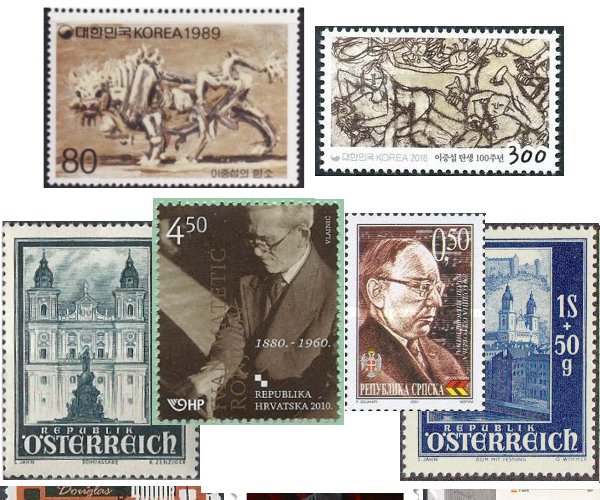The Arts on the Stamps of the World — April 10
An Arts Fuse regular feature: the arts on stamps of the world.

By Doug Briscoe
We have only four artists for today’s article, and no A-listers. The two musical figures were both from the Balkans.
Croatian (Istrian) composer and educator Ivan Ronjgov (10 April 1880 – 27 June 1960) was born Ivan Matetić; he took the name Ronjgov from the name of his birthplace, the village of Ronjgi (or Rojnići). He worked out the “Istrian scale” in consequence of his studies of the folk music of the region. Wikipedia tells us that “[on] the basis of this discovery, Matetić was able to document the folk songs of the Istrian region, to harmonize their notes, and finally to compose music in the same spirit.” Besides his many harmonizations, his original music consists largely of choral works. The stamp was issued in 2010 on the fiftieth anniversary of Ronjgov’s death.
Vlado Milošević (10 April 1901– 2 February 1990) was a Serbian composer and musicologist from Banja Luka. Co-founder of a music school there, he later served as its administrator. He wrote a great deal of music for choir, and in later years expanded to larger forms, with a Violin Concerto dating from 1951, a Dramatic Symphony from 1966, and a number of pieces for string orchestra with and without soloist. He also produced four string quartets and much music for folk orchestra. There is an annual Vlado Milošević Music Festival in Banja Luka.

From the Balkans we move to Korea for Lee Jung Seob (10 April 1916 – 6 September 1956), a painter in oils. He was born in the northern part of the country and fled to Busan on the south coast on the outbreak of the Korean War. Much of the work he was forced to leave behind was destroyed in bombings. Lee and his wife and two children lived in refugee camps for two years until his wife decided to return to her Japanese homeland. Depressed, Lee succumbed to hepatitis and malnutrition at the age of 40. South Korea issued a stamp of his White Ox (1953–54) in 1989 and a new stamp of his tinfoil painting Crabs and Family just last year.
On this date in 1646 died Italian architect and sculptor Santino Solari, born in 1576 (birthday unknown). A native of Verna, near Como, he worked mostly in Austria, particularly in Salzburg, where he was appointed chief architect by Archbishop Markus Sittikus in 1612 and where he is buried. Solari was responsible for Salzburg Cathedral after extensively modifying the plans of Vincenzo Scamozzi. The cathedral was finished in 1628 and would figure prominently in the life of Mozart 150 years later. Solari also worked on the city’s fortifications and on the archbishop’s residence of Hellbrunn Palace with its trick fountains. Solari’s son Ignazio Solari painted the altar piece and some of the frescoes in cathedral. Santino Solari has no stamp of his own, so I show three that were issued to help pay for the postwar reconstruction of the cathedral after it suffered mild damage from a single Allied bomb.
A stamp for English polymath William Hazlitt (10 April 1778 – 18 September 1830) is long overdue.
A graduate of the University of Massachusetts with a B.A. in English, Doug Briscoe worked in Boston classical music radio, at WCRB, WGBH, and WBUR, for about 25 years, beginning in 1977. He has the curious distinction of having succeeded Robert J. Lurtsema twice, first as host of WGBH’s weekday morning classical music program in 1993, then as host of the weekend program when Robert J.’s health failed in 2000. Doug also wrote liner notes for several of the late Gunther Schuller’s GM Recordings releases as well as program notes for the Boston Classical Orchestra. For the past few years he’s been posting a Facebook “blog” of classical music on stamps of the world, which has now been expanded to encompass all the arts for The Arts Fuse.
